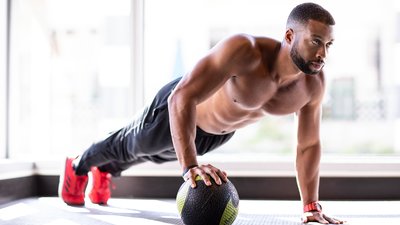"It really doesn't matter—weight is just weight." I've heard this sentiment expressed in many different ways by everyone from anonymous Internet posters to some of the most highly regarded strength coaches in the industry. As the thinking goes, dumbbells, barbells, kettlebells, bodyweight, and sandbags, like the Ultimate Sandbag, are more or less the same thing. Sure, some are slightly better suited to certain movements, but ultimately, it doesn't really matter which one you select. If you are serious about gaining muscle or building strength, you just need to lift the biggest weight possible.
I understand the tempting logic behind this argument—after all, who hasn't believed it at one point in their life?—but with every year I spend training and teaching, I witness more evidence of how it's simply not true. Just ask any bodybuilder who became tired of getting destroyed under overloaded barbells, and then achieved a "miraculous" breakthrough after simply switching to dumbbells.
If you want to be a fully developed athlete, you need a fuller understanding of what it means to be strong. Spending some time working with a sandbag can help you see it, and the program I've shared below can help you achieve it.
The Strength-Stability Connection
Over at Sogn og Fjordane University College in Norway, a pair of professors by the name of Saeterbakken and Fimland have performed a number of experiments in recent years looking at how variations in stability affect muscle activation in a wide range of exercises. The upshot of their work: Looking simply at the amount of weight lifted—or one-rep max strength—can be misleading.
"The exercise with the greatest stability requirement (standing and dumbbells) demonstrated the highest neuromuscular activity of the deltoid muscles, although this was the exercise with the lowest 1RM strength." - Saeterbakken AH, Fimland MS.
In one study, the researchers found that factors such as the inherent instability of a weight and the position of our body may actually be more important in stimulating subjects' muscles than the heaviness of a load. In this study, dumbbells in a less stable body position actually created more muscle activity in the shoulders than a heavier barbell in the more stable position.
It has also been demonstrated that when using unstable surfaces, similar muscle activity can be achieved using reduced loads for the squat and bench press.
As I discussed in my article "Fill in Training Gaps with a Sandbag," I've been a believer in the power of odd-object lifts for years, so hearing about the importance of instability isn't surprising to me. But don't worry, I'm not going to tell you to do all your workouts on a wobble board. Stability, like weight, is just one of the variables you can adjust to maximize the training stimulus. Some others include:
- How you hold a weight
- How you stand when you lift a weight
- The level of stability of the weight you are lifting
- The stability of the surface you are standing on
- The dimensions of the weight
- The plane(s) of motion you are working in
- The speed with which you move or lift
- The range of motion of the movement
- The total amount of work you perform (exercise volume)
- The time you rest between sets and exercises (exercise density)
Ponder that list for a second, and you might realize that your routine is pretty limited in what it asks you to do. That's what led me to create the DVRT training system, to help athletes tap into what most programs are missing, no matter what implements they use. Of course, I happen to believe that the sandbag is special, in that it lends itself to working in all sorts of postures, stances, grips.
In other words, you can build strength that you can express in a wider range of settings, speeds, and situations. As one commenter on my last article noted, if you need more convincing, just ask a Marine. They're no strangers to sandbags.
Take the next step in the sand
If you're looking for a place to start with sandbag training, or if you tried the beginner's circuit in my aforementioned article and want to know what to do next, try on this four-day-a-week program for size.
A lot of these exercises might be new to you, or add new challenges to movements you know, like squats, lunges, curls (yes, you still get to do curls!), and rows. Despite what you might think at first, that's a good thing. This type of training is fun and exciting, but most importantly, it is challenging—particularly if you're accustomed to working in a single plane of motion, with a single grip and a single type of weight. I've also linked to example videos for each movement so you don't feel lost.
These workouts show a relatively simple approach to integrating nearly all the training variables we discussed up above. Welcome to the evolution of fitness and strength training. Give this program a shot and let me know what you think!
Sandbag Strength Program
Workout 1
Superset
- Rotational Lunge: 2 sets of 10-12 reps per side, rest 40 seconds
- Clean and Press: 2 sets of 6-8 reps, rest 40 seconds
Superset
- Bear Hug Squat:2 sets of 8-10 reps, rest 40 seconds
- Staggered Row: 2 sets of 5-6 reps per side with 2-second pause at top, rest 40 seconds
Triset
- Front Loaded Good Morning: 2 sets of 10-15 reps, rest 40 seconds
- Around the World: 2 sets of 8-12 reps per side, rest 40 seconds
- Biceps Curl: 2 sets of 8-10 reps, rest 40 seconds
Workout 2
Superset
- Front Loaded Good Morning: 2 sets of 6-8 reps, rest 40 seconds
- Pull-Up: 2 sets of 5-6 reps, rest 40 seconds
Superset
- Shoulder-Loaded Staggered Squat: 2 sets of 6-8 reps per side, rest 40 seconds
- Spider Man Push-up: 2 sets of 8-12 reps per side, rest 40 seconds
Triset
- Press-Out Lateral Lunge: 2 sets of 8-10 reps per side, rest 40 seconds
- Kneeling Around the World: 2 sets of 6-8 reps per side, rest 40 seconds
- Front Loaded March: 2 sets of 60 seconds, rest 40 seconds
Workout 3
Superset
- Shoulder-Loaded Step-up: 2 sets of 8-10 reps per side, rest 40 seconds
- Rotational Press: 2 sets of 6-8 reps per side, rest 40 seconds
Superset
- Front Squat (shown with barbell): 2 sets of 5-8 reps with three second pause at bottom, rest 40 seconds
- Staggered 1-1/4 Row: 2 sets of 5-6 reps (switch feet alternating sides), rest 40 seconds
Triset
- Shoveling: 2 sets of 10-12 reps per side, rest 40 seconds
- Crunch to Leg Extension: 2 sets of 10-15 reps, rest 40 seconds
- Grip Curl: 2 sets of 10-12 reps, rest 40 seconds
Workout 4
Superset
- Front Loaded Up-Down: 2 sets of 6-8 reps per side, rest 40 seconds
- Chin-Up: 2 sets of 6-8 reps, rest 40 seconds
Superset
- Lateral Step Clean: 2 sets of 6-8 reps per side, rest 40 seconds
- Leverage Push-Up: 2 sets of 8-10 reps per side, rest 40 seconds
Triset
- Bear Hug Squat Hop: 2 sets of 10-15 reps with 2 second pause at bottom, rest 40 seconds
- half Kneeling Arc Press: 2 sets of 5-6 reps per side, rest 40 seconds
- Shoulder Carry: 2 sets of 60 seconds per side, rest 40 seconds
References
- Saeterbakken, A., & Fimland, M. (2013). Effects of Body Position and Loading Modality on Muscle Activity and Strength in Shoulder Presses. Journal of Strength and Conditioning Research, 27(7), 1824-1831.
- Saeterbakken, A. H., & Fimland, M. S. (2013). Muscle force output and electromyographic activity in squats with various unstable surfaces. Journal of Strength & Conditioning Research, 27(1), 130-136.
- Saeterbakken, A. H., van den Tillaar, R., & Fimland, M. S. (2011). A comparison of muscle activity and 1-RM strength of three chest-press exercises with different stability requirements. Journal of Sports Sciences, 29(5), 533-538.


